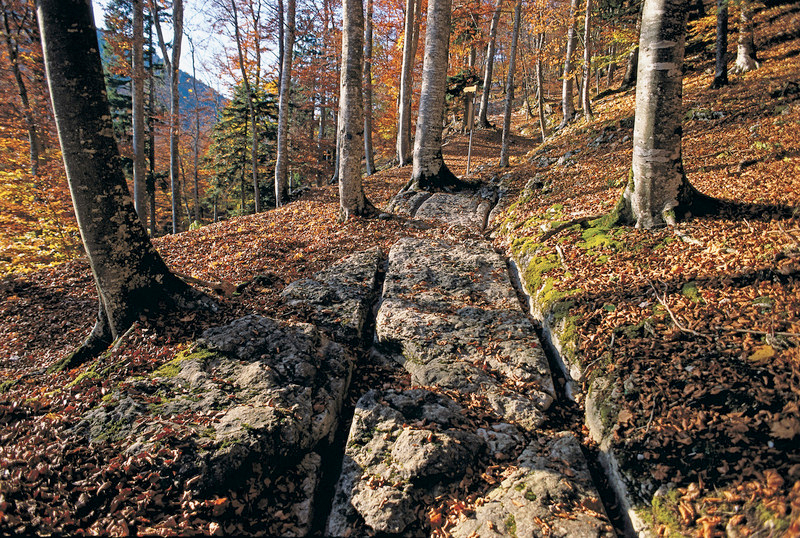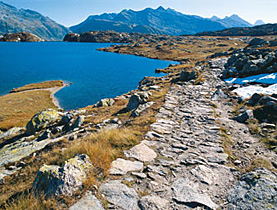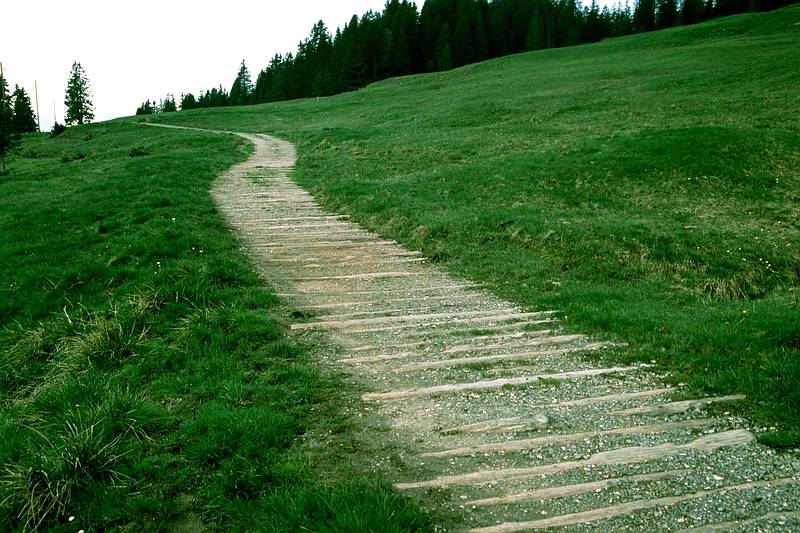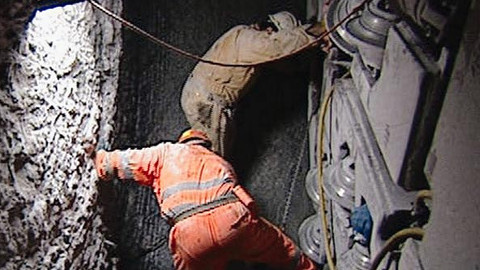Historic routes to be preserved for posterity

Switzerland has always been a transit land, and today is no different. But building for the present often means destroying the past.
Routes used by traders, pilgrims, armies, tourists, … Routes winding over mountain passes, routes painstakingly cut through rock, tunnels, bridges, waterways – all bear witness to Switzerland’s history.
They could all have disappeared, had it not been for a team of geographers and historians who spent 20 years researching and drawing up an inventory of historic routes of national importance, the IVS.
Earlier this year the government approved the inventory, and it comes into force on July 1. This will give legal protection to the listed routes when modern infrastructure – such as roads, pipes, cables and power stations – are being planned.
One of the key figures behind the inventory was Klaus Aerni of the geography institute of Bern University, who started research into alpine passes in the early 1960s as part of his degree.
He relished what he describes as the “joy of discovery”: finding evidence in the landscape of what was already known from documents, and being able to provide the historical context to the remains of structures discovered in the field.
When he began nearly half a century ago, there was no idea of drawing up an inventory. But by the early 1970s he realised that many of the routes that he had investigated had already been lost through the construction of roads and power stations.
“I realised that researching the alpine landscape was not enough to preserve it,” he wrote at the time.
“If it was not protected, future generations would not be able to imagine what the Alps were like before the arrival of motor vehicles.”
Federal support
Plans to preserve the routes gradually took shape. Support at federal level was essential. At the time, the Federal Forestry Office was responsible for the protection of monuments, and Robert Munz, who worked there, acted as a bridge between the researchers and the state.
“There was a lot of interest in the idea,” Munz told swissinfo.ch. “But it’s always difficult to get money from the federation. The people who hold the purse strings are very reticent about giving it out.”
But his commitment paid dividends. The enthusiasm of the researchers and federal support have been the twin reasons for the success of the project.
Field work on the inventory got underway in 1984 as an interdisciplinary cooperation between the geography and history institutes of Bern University, following principles agreed with the Federal Forestry Office.
It was completed in 2003.
Tourism benefits
Of all its achievements, Aerni picked out the rescue of the mule track over the Simplon pass, the Stockalperweg. This became the first “cultural route”, a historically interesting hiking path with an “ecomuseum” explaining the background.
Details of everything on the inventory can be found on an interactive map on the internet, with relevant information and pictures that can be printed or saved.
The Federal Roads Office is now the body responsible for ensuring that the routes are protected, and has an annual budget of some SFr1.2 million ($1.08 million) to help it do so.
It’s money well spent, as Hans Peter Kistler of the Roads Office told swissinfo.ch.
“Every project has very a beneficial impact on the region where it is carried out. All projects contribute to a better understanding of the cultural and natural potential of a region – and to its touristic development,” he said.
When the need to preserve a historic route clashes with the need to build modern infrastructure, there is a statutory procedure for weighing up the interests of the two sides, he explained.
It’s not a matter of preserving history at any cost, as Aerni admits. It is clear that remains will be lost in the face of modern developments. But it is important to try to understand historic sites to fit them into current needs.
“Then we can see if it’s possible and sensible [to preserve them], and decide whether they must be kept just as they are, or where we might be able to improve [plans] by making some adaptations,” he said.
“There’s no such thing as total monument protection.”
Spin-offs
Since the completion of the inventory, the IVS has taken on a life of its own. It has developed into the Center of Transport History, ViaStoria, which has three different branches of activity.
The Center is attached to Bern University and continues to carry out research on different aspects of Swiss transport history.
It also acts as a consultant, helping cantons and communes to apply the rules about historic roads in their planning, and also to draw up their own regional inventories.
But anyone who thinks ViaStoria is simply a dry academic outfit is quite wrong. Its third spin-off is a prize-winning tourist programme, whose made-to-measure packages exploit historic roads to introduce visitors to the delights of slow travel, the appeal of local food and the charm of historic hotels.
ViaStoria has completed its work on what it calls its 12 national Via routes, each of which throws light on a different aspect of Swiss history. It is now working with various cantonal authorities to set up ViaRegio routes to promote sustainable tourism in a similar way in local areas.
The latest ViaRegio route to be launched covers the Unesco natural heritage site of the Aletsch glacier area.
The routes may be old, but they are keeping up with the times.
Julia Slater, swissinfo.ch
The principles guiding the compilation of the inventory included the following:
The inventory to be compiled by field research and investigation of archives; but not by soil probes.
Where possible, the teams should come from the relevant area.
Students to be trained through field experience.
Specialists from different disciplines and representatives of the cantons to support the project.
ViaStoria is the organisation which today researches and maintains historic transport routes.
It developed out of the Inventory of Historic Transport Routes (IVS).
ViaStoria’s main tasks are to carry out research and consultancy work.
It produces a number of publications, in particular the review Wege und Geschichte, and the Magazine of the Cultural Routes in Switzerland.
The Cultural Routes of Switzerland sustainable tourism project is another spin-off of the IVS.
It has organised 12 national ViaRoutes which encourage tourists to hike historic paths and learn about the local culture and enjoy local food.
ViaStoria also has a promotion organisation for interested amateurs.
The Federal Roads Office is responsible for ensuring that historic routes are not lost through the construction of modern infrastructure.
The upkeep of roads is the task of their owners, normally communes or cantons.

In compliance with the JTI standards
More: SWI swissinfo.ch certified by the Journalism Trust Initiative





You can find an overview of ongoing debates with our journalists here. Please join us!
If you want to start a conversation about a topic raised in this article or want to report factual errors, email us at english@swissinfo.ch.